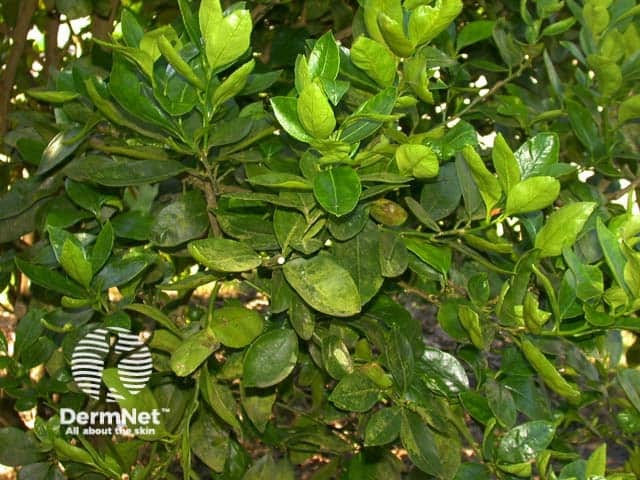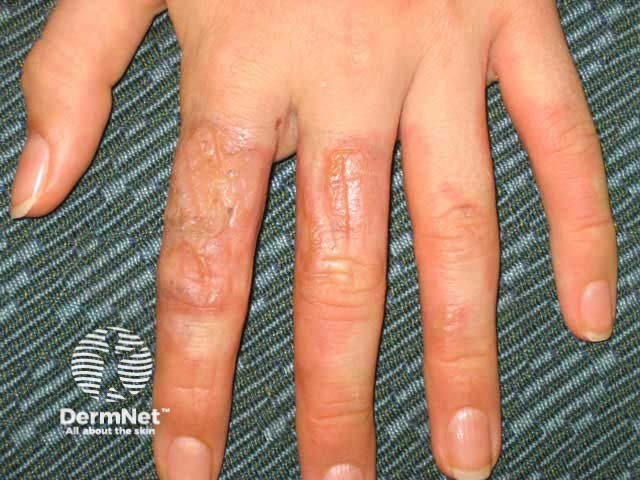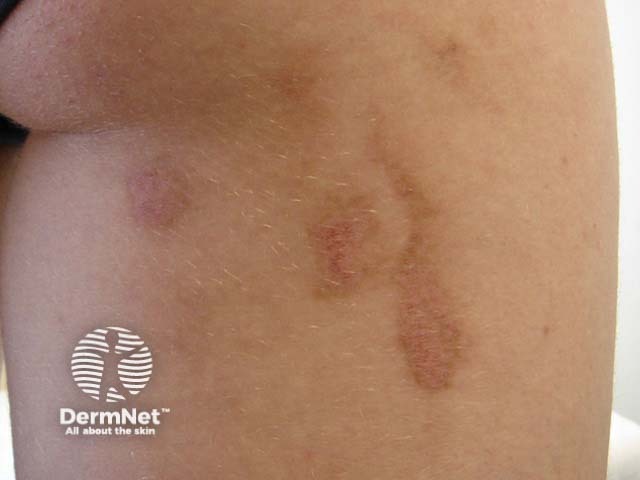Main menu
Common skin conditions

NEWS
Join DermNet PRO
Read more
Quick links
Lime — extra information
Lime
Author: Dr Marius Rademaker, Dept of Dermatology, Waikato Hospital, Hamilton, New Zealand, 1999.
Common name: |
Tahitian lime, Persian lime |
|
Botanical name: |
Citrus latifolia |
|
Family: |
Rutaceae |
|
Origin: |
The origin of the Tahiti lime is unknown. It is presumed to be a hybrid of the Mexican lime (C. aurantiifolia) and citron, or, less likely, the lemon. It is believed that Citrus latifolia was introduced into the Mediterranean region by way of Iran (formerly called Persia). Portuguese traders probably carried it to Brazil, and it was taken to Australia from Brazil around 1824. Most citrus originally came from North East India and South East asia. |
|
Description: |
The Tahiti lime tree is moderately vigorous, medium to large, up to 4.5-6 m, with nearly thornless, with widespread, drooping branches. The leaves are broad-lanceolate, with winged petioles; young shoots are purplish. Flowers are borne during the whole year and are slightly purple-tinged. The fruit is oval, obovate, oblong or short-elliptical, usually rounded at the base, occasionally ribbed or with a short neck; the apex is rounded with a brief nipple; 4-6.25 cm wide, 5-7.5 cm high; peel is vivid green until ripe when it becomes pale-yellow; smooth, thin, tightly clinging; pulp is light greenish-yellow when ripe, in 10 segments, tender, acid, but without the distinctive bouquet of the Mexican lime. It is usually seedless. The Tahiti lime flowers have no viable pollen. |
|

Lime tree

Phototoxic dermatitis from lime juice

Berloque pigmentation from lime juice
Uses: |
As a food source. The peel is used for confectionery as well as in the cosmetic industry. |
Allergens: |
d-limonene, geraniol, citral, furocoumarins (limettin > bergapten > isopimpinellin > xanthotoxin > psoralen) |
Allergy: |
Phototoxic, urticaria and contact dermatitis. Exposure to the peel oil of the Tahiti lime may cause dermatitis. Rolling the limes between the hands before squeezing in order to extract more of the juice will coat the hands with oil and this will be transferred to whatever parts of the body are touched before washing the hands. Subsequent exposure to sunlight often results in a phototoxic reaction (streaky brown or red areas that itch intensely, and sometimes severe blistering). The dermatitis is a form of berloque dermatitis, strictly speaking a reaction to the berlock lime, Citrus bergamia. The sap of the tree and scratches by the thorns may cause rashes in sensitive individuals. There have been some reports of asthma and hayfever from lime pollen. |
Cross reactions: |
Mexican lime, other Citrus spp. |
Other information: |
Lime juice is employed as a rinse after shampooing the hair and on the face as a freshening lotion. Light streaks have been bleached in the hair by applying lime juice and then going out into the sun for a time. One should be sure that there is no peel oil on the hands when doing this. Lime juice is used for cleaning the inside of coffeepots, and to eliminate unpleasant odors from the electric waste-disposal unit. Dilute lime juice will dissolve, overnight, calcium deposits in kettles. Lime juice, given quickly, is an effective antidote for the painful oral irritation and inflammation that result from biting into aroids such as Dieffenbachia spp., Xanthosoma spp., Philodendron spp., and their allies. Lime juice has also been applied to relieve the effects of stinging corals. |
Patch test: |
References
- Cardullo AC, Ruszkowski AM, DeLeo VA. Allergic contact dermatitis resulting from sensitivity to citrus peel, geraniol, and citral. J Am Acad Dermatol. 1989 Aug;21(2 Pt 2):3957
- Picardo M, Rovina R, Cristaudo A, Cannistraci C, Santucci B. Contact urticaria from Tilia (lime). Contact Dermatitis. 1988 Jul;19(1):72-3.
- Bousquet J, Cour P, Guerin B, Michel FB. Allergy in the Mediterranean area. I. Pollen counts and pollinosis of Montpellier. Clin Allergy. 1984 May;14(3):249-58.
- Rudzki E, Rapiejko P, Rebandel P. Occupational contact dermatitis, with asthma and rhinitis, from camomile in a cosmetician also with contact urticaria from both camomile and lime flowers. Contact Dermatitis. 2003 Sep;49(3):162.
- Wagner AM, Wu JJ, Hansen RC, Nigg HN, Beiere RC. Bullous phytophotodermatitis associated with high natural concentrations of furanocoumarins in limes. Am J Contact Dermat. 2002 Mar;13(1):10-4.
- Weber IC, Davis CP, Greeson DM. Phytophotodermatitis: the other "lime" disease. J Emerg Med. 1999 Mar-Apr;17(2):235-7.
- Goskowicz MO, Friedlander SF, Eichenfield LF. Endemic "lime" disease: phytophotodermatitis in San Diego County. Pediatrics. 1994 May;93(5):828-30.
- Nigg HN, Nordby HE, Beier RC, Dillman A, Macias C, Hansen RC. Phototoxic coumarins in limes. Food Chem Toxicol. 1993 May;31(5):331-5.
- Mitchell JC, Rook A, 1979, Botanical Dermatology, Plants and Plant products injurious to the skin, Greengrass, Vancouver.
- Lovell CR.1993, Plants and the Skin, Blackwell, Oxford
- Botanical Dermatology Database.
On DermNet
Other websites
- Berloque dermatitis – emedicine dermatology
